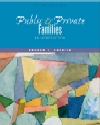EXERCISE 1
The debates about the state of the family and its future can be monitored on the Internet. On the liberal side, the Council on Contemporary Families (www.contemporaryfamilies.org), defends the diversity of American families and argues that the institution is not in decline. On the center-right is the Institute for American Values (www.americanvalues.org), which promotes the idea that the decline of marriage and the increase in single-parent families have harmed children and weakened society. On the right is the Family Research Council (www.frc.org), which supports the "traditional family" in which women stay home to raise children, is strongly pro-life, and opposes gay rights. What evidence do these organizations cite in support of their positions on issues such as the growth of single-parent families? EXERCISE 2 - One Family: Two Perspectives Both liberals and conservatives have their public policy agendas on the family. Visit sites for both sides and compare their take on a particular issue. Conservative policy can be found at Family Research Council (http://www.frc.org/); liberal policy can be found at the Council on Contemporary Families (http://www.contemporaryfamilies.org/). Click on Factsheet or Education on the left in the menu of the Council on Contemporary Families and select a topic. Read the article, and then find the same topic on the Family Research Council site. What are the differences in perspective and reporting? What types of data and justifications are used for each position? EXERCISE 3 - A Global Look at Social Indicator Data Visit the United Nations site at http://www.un.org/english/.
Clickon Economic and Social Development at the top. Click
on Statistics, then click on United Nations Statistical Division
on the left. Then click on Statistical Databases On-Line. Finally,
click on InfoNation. When the site comes up, follow directions by selecting
up to seven countries and four social indicators. Make some comparisons-what
do you think the future holds for these countries based on the data you selected? | 


 2002 McGraw-Hill Higher Education
2002 McGraw-Hill Higher Education